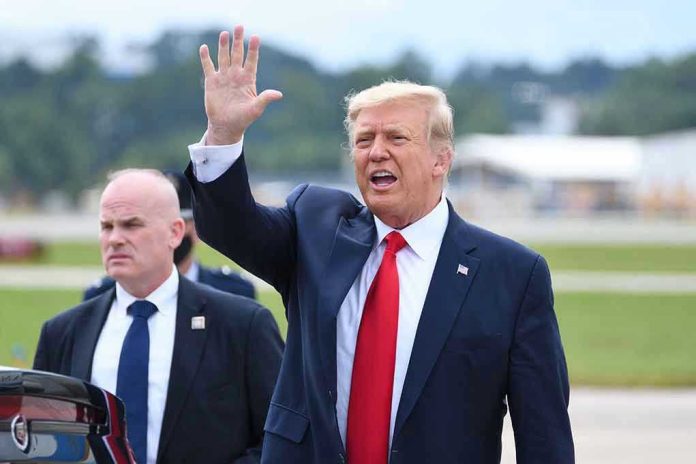
Trump’s landmark peace plan for Israel and Hamas faces fierce resistance from terrorist leaders but wins rare praise from a former Biden official, signaling a seismic shift in Middle East diplomacy.
Story Snapshot
- Trump unveiled a comprehensive 20-point peace proposal to end the Israel-Hamas war, marking a bold diplomatic move.
- Former Biden administration official publicly praised Trump’s plan, highlighting bipartisan recognition of its significance.
- The proposal demands Hamas’s demilitarization and creates a pathway for Palestinian statehood under international oversight.
- Hamas has rejected key terms, while Israel and Arab states cautiously engage in negotiations.
Trump’s 2025 Peace Proposal: Breaking the Deadlock in Gaza
On September 29, 2025, President Donald Trump announced an ambitious 20-point peace initiative at the White House, aiming to halt the bloody conflict between Israel and Hamas. Standing alongside Israeli Prime Minister Benjamin Netanyahu, Trump’s proposal calls for an immediate ceasefire, the safe return of Israeli hostages held in Gaza, and the dismantling of Hamas’s military capabilities. The plan also outlines a transitional governance structure for Gaza, overseen by an international coalition, and sets conditional terms for future Palestinian statehood. This comprehensive approach distinguishes Trump’s proposal from earlier U.S. efforts and seeks to break years of diplomatic gridlock by addressing the war’s root causes and humanitarian fallout.
The significance of Trump’s proposal was amplified when a former Biden administration official—typically viewed as an opponent of conservative foreign policy—publicly endorsed the plan as a “huge step forward.” This rare bipartisan recognition underscores the gravity of the situation and the broad appeal of a solution that prioritizes security, stability, and a path out of endless warfare. Such praise from across the aisle highlights the unprecedented nature of Trump’s intervention and signals hope for real progress, even as entrenched opposition from Hamas and deep divisions in Israeli politics remain.
Stakeholders and Power Dynamics: Who Stands to Gain or Lose?
Trump’s peace plan puts key players at the negotiating table. For Netanyahu and Israel, the proposal promises security guarantees, the return of hostages, and a fresh opportunity to reshape Gaza’s future without direct military occupation. Meanwhile, Hamas faces the demand to disarm and submit to international oversight, a condition it has vehemently rejected. Arab states and the broader international community are drawn in as potential guarantors of stability and reconstruction, with the promise of ending cycles of violence that spill into neighboring countries. The United States, under Trump’s restored leadership, reasserts its role as a decisive mediator, leveraging relationships built during the Abraham Accords and prior diplomatic successes.
Despite overwhelming military superiority, Israel is subject to intense global scrutiny and pressure for a lasting peace. Hamas, isolated diplomatically and battered militarily, remains a wild card, capable of derailing negotiations if it refuses to relinquish arms. Arab states, while cautiously optimistic, recognize that regional stability depends on a solution that delivers both security and humanitarian relief. This intricate web of interests makes Trump’s plan a test of diplomatic resolve, with outcomes that will reverberate throughout the Middle East and beyond.
Immediate Obstacles and International Reactions
The main stumbling block for Trump’s proposal is Hamas’s outright rejection of the demilitarization requirement. Without Hamas’s cooperation, the ceasefire and pathways to reconstruction remain uncertain. Nevertheless, the international response has been broadly supportive, with France, Egypt, and Gulf states signaling readiness to participate in oversight and funding for Gaza’s recovery. Netanyahu, while grateful for Trump’s leadership, remains firm in his opposition to Palestinian statehood, highlighting persistent divisions within Israel’s government. Arab states, on the other hand, welcome the plan’s focus on humanitarian relief and governance reform, seeing it as a chance to stabilize the region and curb extremist influence.
Diplomatic efforts continue as world leaders press Hamas to reconsider, emphasizing the urgency of ending hostilities and restoring normalcy for civilians caught in the crossfire. The U.S. administration’s commitment to Israel’s security remains unwavering, but Trump has challenged all parties to seize this rare opportunity for peace. The complexity of the situation is heightened by the involvement of international organizations and the need for broad-based buy-in to achieve lasting change.
‘Huge step forward’: Former Biden official praises Trump’s peace deal proposal to end Israel-Hamas war https://t.co/3bu8gijD0N
— BPR (@BIZPACReview) September 30, 2025
Short-term, successful adoption of the plan could mean an immediate ceasefire and relief for families in Gaza and southern Israel. Long-term, it offers a conditional pathway to Palestinian statehood—an unprecedented shift in U.S. policy—and promises to reshape regional alliances, spur economic reconstruction, and give humanitarian groups access for large-scale aid. Critics warn that without Hamas’s acceptance, the plan could stall, but experts agree that the ambitious scope and international support mark a critical turning point in a conflict defined by decades of missed opportunities.
Expert Perspectives and the Road Ahead
Bipartisan praise, particularly from a former Biden official, signals serious momentum behind Trump’s plan. Middle East analysts highlight the proposal’s comprehensive framework, noting that international stabilization forces and conditional statehood set it apart from previous attempts. Security experts argue that lasting peace will require both robust oversight and genuine buy-in from all parties. Skepticism persists among some Israeli and Palestinian factions, but broad consensus is building around the need for bold leadership and common-sense solutions. The coming weeks will determine whether Trump’s initiative can overcome entrenched opposition and deliver on its promise to restore peace, stability, and constitutional values in the region.
Sources:
Donald Trump’s September 2025 Gaza Strip Proposal – Wikipedia














